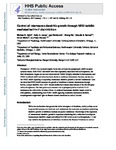Control of interneuron dendritic growth through NRG1/erbB4-mediated kalirin-7 disinhibition
| dc.contributor.author | Cahill, ME | |
| dc.contributor.author | Jones, KA | |
| dc.contributor.author | Rafalovich, I | |
| dc.contributor.author | Xie, Z | |
| dc.contributor.author | Barros, Claudia | |
| dc.contributor.author | Müller, U | |
| dc.contributor.author | Penzes, P | |
| dc.date.accessioned | 2016-04-23T17:19:22Z | |
| dc.date.available | 2016-04-23T17:19:22Z | |
| dc.date.issued | 2012-01 | |
| dc.identifier.issn | 1359-4184 | |
| dc.identifier.issn | 1476-5578 | |
| dc.identifier.uri | http://hdl.handle.net/10026.1/4539 | |
| dc.description.abstract |
Neuregulin 1 (NRG1) is a secreted trophic factor that activates the postsynaptic erbB4 receptor tyrosine kinase. Both NRG1 and erbB4 have been repeatedly associated with schizophrenia, but their downstream targets are not well characterized. ErbB4 is highly abundant in interneurons, and NRG1-mediated erbB4 activation has been shown to modulate interneuron function, but the role for NRG1-erbB4 signaling in regulating interneuron dendritic growth is not well understood. Here we show that NRG1/erbB4 promote the growth of dendrites in mature interneurons through kalirin, a major dendritic Rac1-GEF. Recent studies have shown associations of the KALRN gene with schizophrenia. Our data point to an essential role of phosphorylation in kalirin-7's C terminus as the critical site for these effects. As reduced interneuron dendrite length occurs in schizophrenia, understanding how NRG1-erbB4 signaling modulates interneuron dendritic morphogenesis might shed light on disease-related alterations in cortical circuits. | |
| dc.format.extent | 99-107 | |
| dc.format.medium | Print-Electronic | |
| dc.language | en | |
| dc.language.iso | eng | |
| dc.publisher | Springer Science and Business Media LLC | |
| dc.subject | PSD-95 | |
| dc.subject | fyn | |
| dc.subject | src | |
| dc.title | Control of interneuron dendritic growth through NRG1/erbB4-mediated kalirin-7 disinhibition | |
| dc.type | journal-article | |
| dc.type | Journal Article | |
| dc.type | Research Support, N.I.H., Extramural | |
| dc.type | Research Support, Non-U.S. Gov't | |
| plymouth.author-url | https://www.webofscience.com/api/gateway?GWVersion=2&SrcApp=PARTNER_APP&SrcAuth=LinksAMR&KeyUT=WOS:000299014000014&DestLinkType=FullRecord&DestApp=ALL_WOS&UsrCustomerID=11bb513d99f797142bcfeffcc58ea008 | |
| plymouth.issue | 1 | |
| plymouth.volume | 17 | |
| plymouth.publication-status | Published | |
| plymouth.journal | Molecular Psychiatry | |
| dc.identifier.doi | 10.1038/mp.2011.35 | |
| plymouth.organisational-group | /Plymouth | |
| plymouth.organisational-group | /Plymouth/Faculty of Health | |
| plymouth.organisational-group | /Plymouth/Faculty of Health/Peninsula Medical School | |
| plymouth.organisational-group | /Plymouth/REF 2021 Researchers by UoA | |
| plymouth.organisational-group | /Plymouth/REF 2021 Researchers by UoA/UoA01 Clinical Medicine | |
| plymouth.organisational-group | /Plymouth/Users by role | |
| plymouth.organisational-group | /Plymouth/Users by role/Academics | |
| plymouth.organisational-group | /Plymouth/Users by role/Researchers in ResearchFish submission | |
| dc.publisher.place | England | |
| dc.identifier.eissn | 1476-5578 | |
| dc.rights.embargoperiod | Not known | |
| rioxxterms.versionofrecord | 10.1038/mp.2011.35 | |
| rioxxterms.licenseref.uri | http://www.rioxx.net/licenses/all-rights-reserved | |
| rioxxterms.type | Journal Article/Review |


